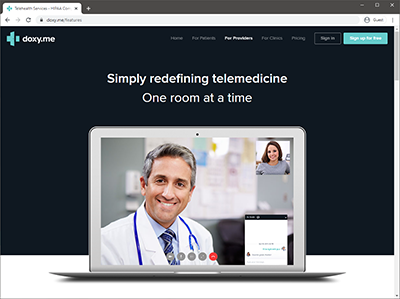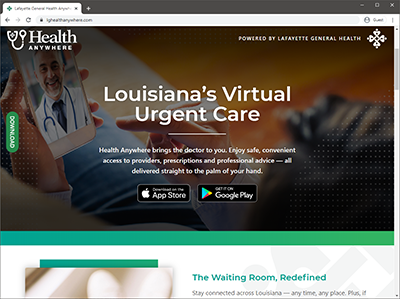Telehealth Quick Start Guide for Louisiana Medicaid Providers
Date: 04/07/20
As COVID19 drives more and more healthcare to virtual visits, this quick introduction is designed to help Medicaid providers who are looking to get started with telehealth. Below is a summary of key benefits, emergency policies and telehealth platform options for providers, including links to some common telehealth solutions.
Benefits of Telehealth for Patients, Providers and the Public
In March 2020, in response to the state’s battle against the COVID-19 pandemic, Louisiana’s Medicaid program adopted an innovative and aggressive approach to telehealth. The use of telehealth during this pandemic yields numerous benefits, including:
- Stop the Spread: Enabling ‘forward triage’ and patients to receive care from their homes reduces the risk of patient and provider exposure to the virus.
- Stabilize Revenue: Providing services via telehealth can create new revenue streams to offset reduced visit volume during this pandemic.
- Increase Capacity: Caring for patients via telehealth can reduce the burden on hospitals as they deal with the increased COVID19 caseload, effectively increasing the capacity of the healthcare system during this crisis.
Expanded Telehealth Access for Medicaid Enrollees
Recognizing the critical need for telehealth services during the COVID-19 pandemic, the Louisiana Department of Health encourages the use of telehealth to decrease the potential for patient-to-patient or patient-to-provider transmission of the virus.
LDH has expanded access to telehealth and provided detailed service-specific guidance. When otherwise covered by Louisiana Medicaid, telehealth is allowed for all CPT codes located in Appendix P of the CPT manual. These codes include, but are not limited to, new and established outpatient office visit codes.![]()
In addition, they have issued specific guidance on telehealth for:
- Physical, occupational and speech therapy (PT/OT/ST)
- Applied Behavioral Analysis (ABA)
- Outpatient substance use treatment
- Licensed mental health providers
- Mental health rehabilitation
View the latest provider guidance from LDH on the COVID19 Medicaid Information page.
Please note that providers should still adhere to all requirements of their licensing board and should check with their medical malpractice carrier related to telehealth.
Choosing a Telehealth Solution
When a provider decides to get started with telehealth, there are two main paths to consider. They can implement an independent platform that is specific to their practice and patients, or they can join an existing telehealth network. Or both!
Platform for Your Practice – Bring Your Own Patients
If a provider’s main goal is to continue seeing their practice’s patients, they should consider implementing a telehealth platform for their practice. The key distinguishing characteristic of these platforms is that they enable telehealth visits with patients of a specific practice, not a broad network of new patients.
There are many free and paid telehealth platform options, ranging from simple to full-featured. The process of implementing a platform for your practice varies based on what features and system integrations are desired. Integrating with an EMR and practice management software will take longer than setting up basic video call capabilities.
When implementing a telehealth platform, it is important to promote the new service to patients so they know how to access it.
Some Common Telehealth Platforms
- Doxy.me: an easy, browser-based solution that is a common choice for providers starting with telehealth. Free and paid tiers available.
- Relief Telemed: a Baton Rouge-based company helping providers establish their telehealth platform. For more information, contact Vishal Vasanji, vishal@relieftelemed.com.
- Zoom Healthcare: a secure, HIPAA-compliant platform for video calls with patients.
Telehealth Network – Expand Your Care
If a provider wants to see additional patients to help with the COVID19 crisis and add a new revenue stream, joining a telehealth network may be a beneficial decision. Especially during this time, a telehealth network may provide supplemental revenue that can offset the decline in volume many are experiencing.
The key distinguishing characteristic of telehealth networks is that providers care for patients of the telehealth network, not of their own specific practice.
Some hospitals in Louisiana already have structured telehealth systems in place. For example, Lafayette General Medical Center, located in Lafayette, La., is currently seeing Medicaid members via telehealth encounters, and receiving high marks from patients who have completed those visits.
Providers may also choose to join an established, national network, such as Teladoc or AmWell. Due to relaxed regulations during this crisis, by joining a national network, providers can contribute to the COVID19 response by serving telehealth patients in other states, as well.
Joining a telehealth network may also generate a significant volume of telehealth visits more quickly, because the provider does not have to market the platform to their patients to get started.
Some Common Telehealth Networks
- Lafayette General Medical Center: currently enrolling new providers to their Louisiana-based telehealth network. To join, contact Michael Dozier at mjdozier@lgh.org.
- Teladoc and AmWell: both are established telehealth networks serving patients and accepting providers nationwide.
Non-HIPAA Compliant Emergency Options
If available, providers should utilize a HIPAA-compliant platform for telehealth visits. During the pandemic, CMS and LDH will permit a non-HIPAA compliant platform if necessary.
If a HIPAA-compliant system is not immediately available at the time it is needed, providers may use everyday communications technologies (like FaceTime, Google Duo or Microsoft Teams for video chat).
Additionally, if an audio and video visit is not possible at the time it is needed, an audio-only visit is permissible if possible for the clinical nature of the service being provided and if the same standard of care is met.
Be aware that these are emergency provisions during the COVID19 pandemic, and are not likely to be allowed permanently. Please refer to the LDH provider notices for more details.
The Time Is Now
According to the American Telemedicine Association, telehealth-enabled providers are reporting reduced costs of care delivery, increased efficiency and revenue, and expanded patient access to care as benefits of adopting telehealth. Now, during the COVID-19 pandemic, telehealth offers Louisiana’s providers a ready-made solution to address the virus – safely, efficiently, and without risking patient health or satisfaction.
